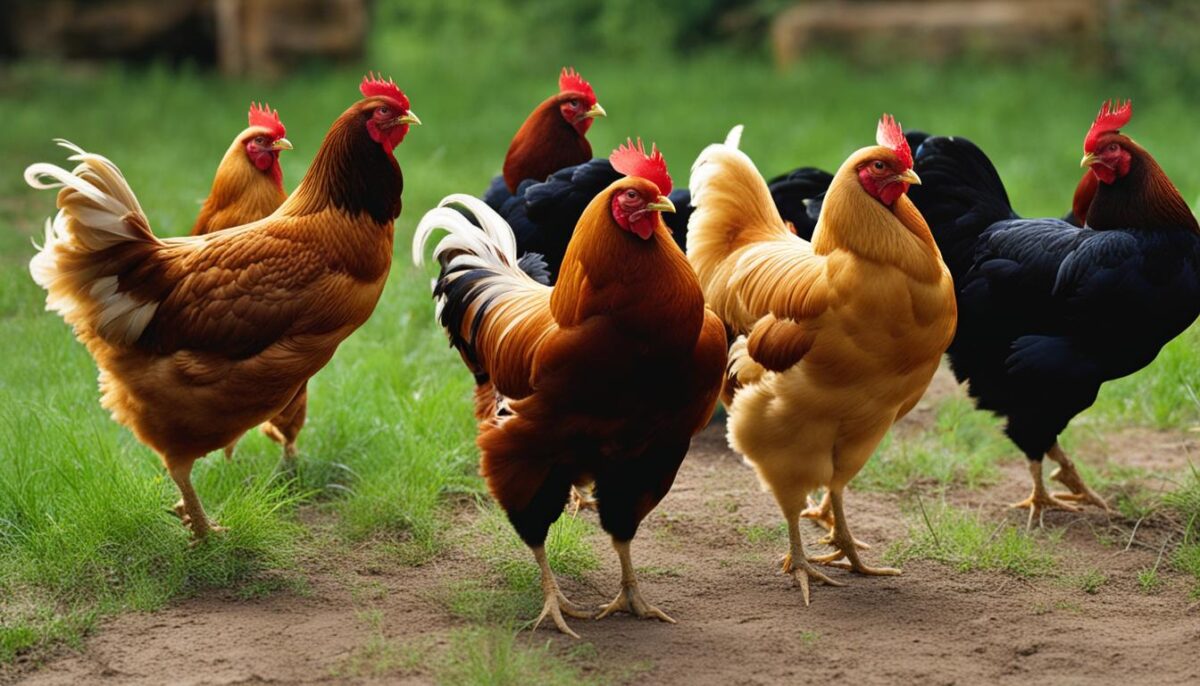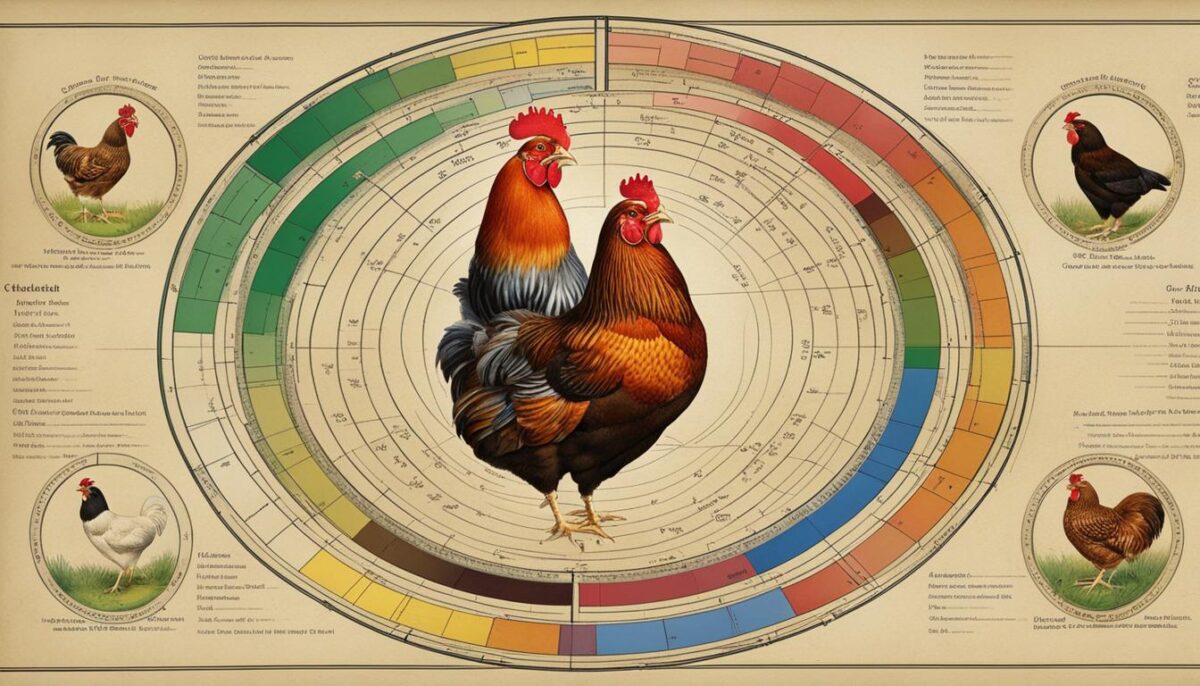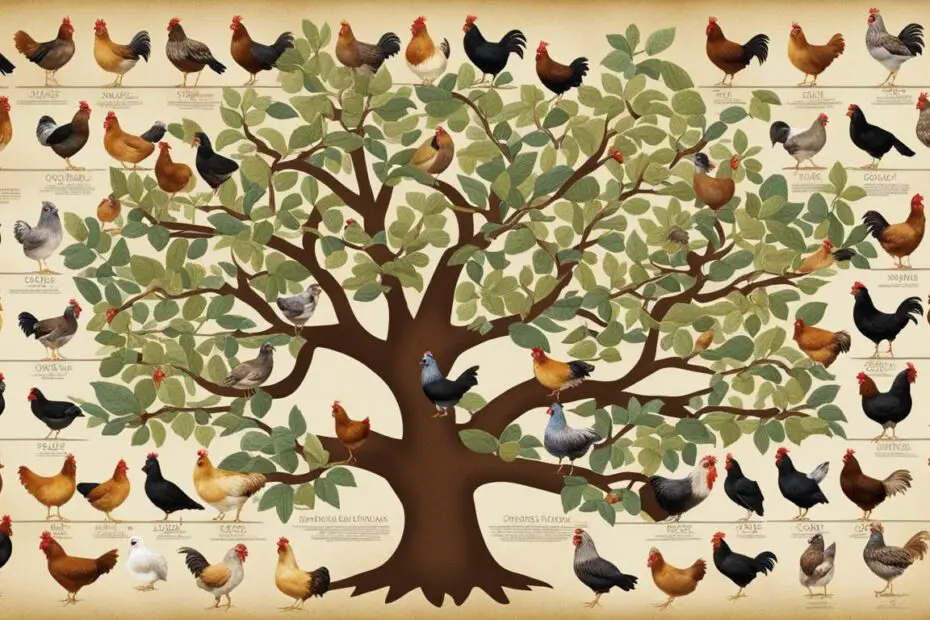Welcome to our ultimate guide to chicken line breeding charts. If you’re a poultry farmer or a chicken enthusiast looking to enhance and maintain specific genetic traits within your flock, linebreeding can be a valuable tool. In this guide, we’ll explore the concept of linebreeding, its advantages and disadvantages, and how to implement it in your chicken breeding program. We’ll also discuss a related breeding method called clan mating. So, let’s dive in and discover the world of chicken genetics and breeding charts!
Key Takeaways:
- Linebreeding is a form of selective breeding that uses closely related chickens to concentrate desirable traits.
- It can improve show quality, production traits, and certain physical attributes in chicken breeds.
- While linebreeding has advantages such as creating a more uniform flock, it also carries risks like genetic defects and reduced genetic diversity.
- Implementing a linebreeding program requires careful selection, monitoring, and record-keeping across multiple generations.
- Clan mating, another breeding method, can help preserve genetic diversity and enable the maintenance of closed flocks.
What is Linebreeding?
Linebreeding is a form of selective breeding where closely related chickens are mated to each other. This breeding technique aims to concentrate desirable genetic traits by using birds that are closely related, often sharing a common ancestor. By selecting and mating birds that exhibit the target traits, breeders reinforce the presence of these characteristics in future generations. Linebreeding is a technique commonly used in poultry farming to improve specific traits such as egg production, meat quality, and physical attributes in chicken breeds.
Linebreeding involves careful selection of breeding stock based on the desired traits. By mating closely related chickens, breeders increase the chances of passing on the desired genetic traits to the offspring. This technique helps create a more uniform flock with consistent characteristics. Uniformity in traits such as size, color, and feather pattern is highly valued in poultry farming for both practical and aesthetic reasons.
When practicing linebreeding, it is important to maintain genetic diversity within the flock. Breeders need to carefully monitor the health and vigor of the linebred flock to prevent the accumulation of harmful genetic defects. Regular evaluation and selection of breeding stock help maintain the overall quality of the linebred flock and prevent the negative effects of inbreeding.
Table: Pros and Cons of Linebreeding
| Pros | Cons |
|---|---|
| Concentrates desirable traits | Increases the risk of genetic defects |
| Creates a more uniform flock | Reduces genetic diversity |
| Improves specific traits such as egg production and meat quality | Requires careful selection and monitoring |
Linebreeding can be a powerful tool for poultry breeders to improve and maintain desired genetic traits within a lineage. However, it requires careful management, selection, and monitoring to strike a balance between concentrating beneficial traits and maintaining genetic diversity.
Advantages and Disadvantages of Linebreeding
Linebreeding, as a form of selective breeding, offers several advantages and disadvantages for poultry farmers and breeders. Understanding these pros and cons is crucial for making informed decisions in linebreeding programs. Let’s explore both sides of the coin.
Advantages of Linebreeding
“Linebreeding allows breeders to concentrate desirable genetic traits and maintain specific lines over time.”
One of the key advantages of linebreeding is the ability to improve show quality and production traits in chickens. By selectively mating closely related birds that exhibit the desired traits, breeders can strengthen and maintain these characteristics within a lineage. Linebreeding also allows for the creation of a more uniform flock, which can be advantageous for commercial purposes.
Linebreeding facilitates the preservation and enhancement of genetic lines, ensuring the continuity of specific traits from generation to generation. This technique promotes the development of bloodlines with consistent qualities, such as improved egg production, meat quality, or physical attributes. It provides breeders with the opportunity to refine and perfect specific traits over time.
Disadvantages of Linebreeding
“The risk of genetic defects and reduced genetic diversity are significant disadvantages of linebreeding.”
While linebreeding offers advantages, it also comes with inherent risks. One major drawback is the increased potential for genetic defects. When closely related birds are bred together over successive generations, the likelihood of inherited disorders or health problems amplifies. This risk emphasizes the need for careful selection and monitoring to prevent the negative consequences of inbreeding.
Another disadvantage of linebreeding is the reduction of genetic diversity within a flock. By repeatedly mating closely related birds, breeders restrict the gene pool and limit the variety of genetic traits available. This reduced genetic diversity can make the flock more vulnerable to diseases and other environmental challenges. It is crucial for breeders to implement measures to preserve genetic diversity and ensure the long-term viability and health of the flock.
| Advantages of Linebreeding | Disadvantages of Linebreeding |
|---|---|
| Concentrates desirable genetic traits | Increases the risk of genetic defects |
| Maintains specific lines and bloodlines | Reduces genetic diversity within the flock |
| Improves show quality and production traits | Makes the flock more susceptible to diseases |
| Creates a more uniform flock |
How to Linebreed Chickens
Linebreeding chickens is a meticulous process that requires careful selection and monitoring to ensure the desired genetic traits are passed down through generations. Here is a step-by-step guide on how to successfully linebreed your chickens:
Step 1: Select the Breeding Stock
Start by choosing a group of chickens that possess the desired traits you want to concentrate. These birds will serve as the foundation stock for your linebreeding program. It is important to have a clear understanding of the specific genetic traits you are looking to enhance in your flock.
Step 2: Breed Closely Related Birds
Once you have your breeding stock, mate closely related birds within the same family or line. This can include parent-offspring matings, full sibling matings, or matings between half-siblings. The goal is to concentrate the desired traits in the offspring by selecting birds that exhibit those traits.
Step 3: Evaluate and Select the Best Offspring
After the matings, carefully evaluate the offspring for the desired traits. Select the best birds that exhibit those traits and use them as breeding stock for the next generation. It is crucial to keep detailed records of each bird’s lineage, including parentage and performance data.
Step 4: Repeat the Process for Multiple Generations
Continue the linebreeding process for multiple generations, always selecting the best offspring for breeding. With each generation, the concentration of desired traits should increase. However, it is important to closely monitor the health and vigor of the flock to avoid any negative effects of inbreeding.
| Generation | Number of Selected Breeding Birds | Percentage of Desired Traits |
|---|---|---|
| 1 | 10 | 50% |
| 2 | 8 | 65% |
| 3 | 6 | 80% |
| 4 | 4 | 90% |
| 5 | 2 | 95% |
Table: Example of linebreeding progress over multiple generations, showing the number of selected breeding birds and the percentage of desired traits.
What is Clan Mating?
Clan mating, also known as spiral mating, is a form of selective breeding that promotes genetic diversity and the maintenance of closed flocks. Unlike traditional linebreeding, clan mating involves separating chickens into at least three different groups or clans. In the initial year, chickens within each group mate exclusively with others from the same clan. In subsequent years, the males are rotated to the next clan, ensuring that genes from different clans are mixed. This method helps to prevent inbreeding and maintain the overall health and vigor of the flock.
One of the key advantages of clan mating is its ability to preserve genetic diversity. By allowing chickens to mate within their own clan for the first year and then switching males between clans, breeders can avoid the negative effects of inbreeding. This technique helps to minimize the risk of genetic defects and maintain the overall genetic health of the flock. Additionally, clan mating enables breeders to keep closed flocks for extended periods, reducing the need for introducing outside genetics.
To implement a successful clan mating program, separate housing is required for each clan during the breeding season. However, chickens can continue to live in a social flock situation year-round without the need for individual pens. This simplifies management practices and allows chickens to maintain their natural social dynamics. Overall, clan mating is an effective breeding strategy that helps ensure the long-term genetic health and diversity of a chicken flock.

| Advantages | Disadvantages |
|---|---|
| Preserves genetic diversity | Requires separate housing for each clan during breeding season |
| Maintains closed flocks | Improvement in desired traits may occur more slowly compared to other breeding methods |
| Simplifies management practices |
Pros and Cons of Clan Mating
Clan mating, also known as spiral mating, offers several advantages and disadvantages for breeders. Understanding these pros and cons can help poultry farmers make informed decisions about incorporating this breeding strategy into their flock management. Let’s explore the benefits and challenges of clan mating in more detail.
Pros of Clan Mating
- Preservation of Genetic Diversity: Clan mating allows for the maintenance of genetic diversity within a flock. By rotating males between clans each year, breeders can avoid excessive inbreeding and prevent the loss of valuable genetic traits.
- Extended Closed Flocks: Clan mating enables breeders to keep closed flocks for extended periods. This is particularly advantageous for preserving rare or specialized chicken breeds, as it reduces the risk of introducing genetic material from outside sources.
- Simplified Management: With clan mating, chickens can live in social flock situations, eliminating the need for individual pens. This reduces the complexity of managing breeding groups and simplifies day-to-day flock management practices.
Cons of Clan Mating
- Slower Trait Improvement: While clan mating can help preserve genetic diversity, it may lead to slower improvement in desired traits compared to other breeding methods. It takes time for traits to accumulate and become more consistent within each clan as breeding occurs within a smaller gene pool.
- Separate Housing Requirements: Clan mating requires separate housing for each clan during the breeding season. This can add logistical challenges and may require additional space and infrastructure to accommodate multiple breeding groups.
In summary, clan mating offers the benefits of preserving genetic diversity, maintaining closed flocks, and simplifying flock management. However, breeders should be aware of the potential for slower trait improvement and the need for separate housing. By carefully considering these pros and cons, poultry farmers can determine if clan mating aligns with their breeding goals and flock management practices.
How to Create a Clan Mating Program for Your Flock
Creating a clan mating program for your flock is a simple and effective way to implement selective breeding and maintain genetic diversity. By following a few key steps, you can establish a successful program that allows you to improve and preserve desirable traits in your chicken flock.
Step 1: Establish Breeding Groups
Start by creating at least three breeding groups or clans within your flock. Each group should consist of several cocks and hens, and can be randomly formed or based on specific criteria. By having multiple breeding groups, you promote genetic diversity and reduce the risk of inbreeding.
Step 2: Rotate the Best Cocks
In the second year and beyond, select the best females from each breeding group to remain within their respective clans. Rotate the best cock from each group to the next, ensuring that each clan experiences new genetic contributions. This promotes genetic diversity and prevents the negative effects of inbreeding.

To maintain a successful clan mating program, it is essential to keep detailed records of clan membership and breeding decisions. This includes recording which chickens belong to each clan, as well as which chickens were selected for breeding in each generation. By keeping accurate records, you can make informed breeding decisions and track the progress of your breeding program over time.
Step 4: Maintain the Program
Consistency is key to the success of a clan mating program. Continuously evaluate the performance and traits of the chickens in each clan, and make adjustments as necessary. Regularly introduce new genetic material from outside sources to further enhance genetic diversity and prevent stagnation within the program.
By following these steps and maintaining a well-documented clan mating program, you can effectively implement selective breeding in your flock while preserving genetic diversity. This program allows you to improve and maintain desirable traits, creating a healthier and more robust chicken flock.
Pedigree and Tracking in Clan Mating
In a clan mating system, keeping track of clan membership and maintaining detailed records is crucial for effective breeding. While it is not necessary to track the exact parentage of each chicken, knowing which clan each chicken belongs to is essential. This can be achieved through simple record-keeping techniques.
One way to track clan membership is by labeling eggs. As eggs are collected, they can be separated by clan and labeled accordingly. This ensures that chicks hatched from these eggs are assigned to the correct clan based on their mother’s membership.
Another method is to use colored rubber leg bands to identify chicks. Each clan can be assigned a different color, making it easy to identify which clan a chick belongs to. By using these leg bands, breeders can quickly determine the clan membership of each chicken without the need for complex record-keeping.
While the focus in a clan mating system is not on individual pedigrees, it is still important to maintain records of breeding decisions and performance data. This information helps breeders make informed decisions when selecting birds for future generations. By keeping track of which individuals are selected as breeders and monitoring the performance of their offspring, breeders can continue to improve and refine their breeding program over time.
FAQ
What is linebreeding?
Linebreeding is a form of selective breeding where closely related chickens are mated to each other to concentrate desirable genetic traits.
What are the advantages of linebreeding?
Linebreeding can improve show quality, production traits, and create a more uniform flock.
What are the disadvantages of linebreeding?
Linebreeding can increase the risk of genetic defects and reduce genetic diversity within a flock, making them more susceptible to diseases.
How do I linebreed chickens?
To linebreed chickens, select a group of chickens with desired traits as the foundation stock and breed closely related birds within the same family or lineage together. Evaluate the offspring for desired traits and select the best birds for breeding in the next generation.
What is clan mating?
Clan mating, also known as spiral mating, is a form of selective breeding where chickens are separated into at least three different groups or clans. In the initial year, chickens mate within their own group, and in subsequent years, the males are rotated to the next clan.
What are the pros of clan mating?
Clan mating preserves genetic diversity and allows breeders to maintain closed flocks for extended periods. It also simplifies management practices by allowing chickens to live in social flock situations.
What are the cons of clan mating?
Improvement in desired traits may occur more slowly compared to other breeding methods, and separate housing is required for each clan during the breeding season.
How do I create a clan mating program for my flock?
Create at least three breeding groups or clans, assign each group a name or number, and select the best females from each group to remain within their clan while rotating the best cocks to the next group each year.
How do I track pedigree and clan membership in clan mating?
Detailed record-keeping is essential to track clan membership and breeding decisions. This can be done by using labels on eggs, separating eggs by clan during incubation, and using colored rubber leg bands to identify chicks. Assigning chicks to the clan of their mother ensures accuracy in clan membership.


